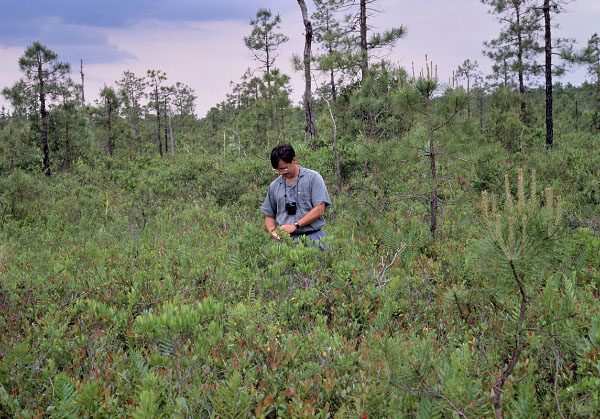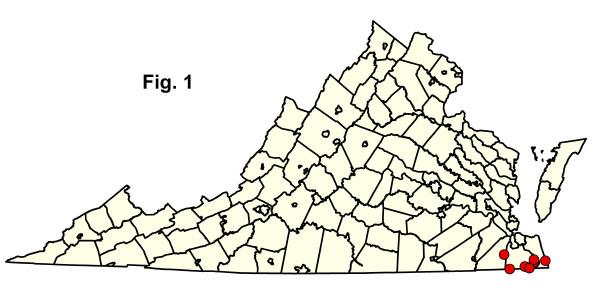
 إدارة الحفاظ على البيئة والترفيه
إدارة الحفاظ على البيئة والترفيه احفظ. احمِ. استمتع.
 إدارة الحفاظ على البيئة والترفيه
إدارة الحفاظ على البيئة والترفيه  جدول المحتويات
جدول المحتوياتغابات بوند باين وودلاندز بوكوسينز
This ecological group is characterized by coniferous, pyrophytic woodlands of saturated, oligotrophic, Coastal Plain peatlands. These communities are restricted to southeastern Virginia, eastern North Carolina, and northeastern South Carolina. Although no doubt more widespread in the pre-settlement Virginia landscape, only a few remnants of these communities are currently found in the extreme southeastern part of the state. The largest extant occurrences are in the Great Dismal Swamp National Wildlife Refuge (Cities of Suffolk and Chesapeake) and on remote peat flats beyond the range of wind-tidal flooding along the North Landing River (City of Virginia Beach) and Northwest River (City of Chesapeake). Pond Pine Woodlands and Pocosins have high biomass and consist largely of inflammable woody plants that are specially adapted to frequent, intense burning. All present-day examples in Virginia suffer to some extent from a reduction in fire frequencies or complete suppression of fires. Stand physiognomy and composition reflect responses to gradients of fire frequency and peat depth. Stands known as "high pocosins" are associated with deeper organic soils and more frequent fires; these have only scattered, stunted pond pines (Pinus serotina) emergent from nearly impenetrable evergreen shrub thickets dominated by shining fetterbush (Lyonia lucida), inkberry (Ilex glabra), Carolina laurel (Kalmia carolina), and laurel-leaf greenbrier (Smilax laurifolia). Stands associated with superficial peat and/or longer periods without fire often develop nearly closed canopies of larger pond pines, understories of red maple (Acer rubrum), sweetbay magnolia (Magnolia virginiana var. virginiana), and red bay (Persea palustris), and less dense shrub layers that contain more deciduous species. Few herbaceous species except Virginia chain fern (Anchistea virginica) thrive in pond pine woodlands.
كانت غابات الصنوبر البرك فوق حوامل كثيفة من قصب التبديل(Arundinaria tecta) المعروفة باسم "canebrakes،" شائعة في مناطق منطقة المستنقعات الديسمالية التي كانت فترات عودة الحرائق فيها قصيرة جداً. وبسبب استبعاد الحرائق، تم استبدال هذه الغابات في تعاقبها بغابات غير نهرية، على الرغم من بقاء نظائرها غير الطبيعية في حقوق مرور خطوط الكهرباء التي يتم الحفاظ عليها عن طريق القص ومبيدات الأعشاب.
تتشابه غابات الصنوبر في البركة وغابات البوكوسين من الناحية الزهرية مع كل من غابات الأرز الأبيض الأطلنطي في الأراضي الخثية وغابات المستنقعات المختلطة دائمة الخضرة من غابات المستنقعات غير النهرية. وهي تختلف عن الأولى في هيمنة الشجرة العلوية، وكثافة الشجيرات الأكبر، والارتباط بالأراضي الخثية التي كانت في السابق تخضع لفترات أقصر بكثير من فترات عودة الحرائق. تتميز غابة المستنقعات غير النهرية (النوع المختلط دائم الخضرة) بمظلة أكثر تنوعاً، وتحتل مستنقعات أكثر رطوبة في مناطق الكثبان الرملية أو الكثبان الرملية القديمة، ومن المحتمل أن تختلف عن مجتمعات الصنوبر البرك في عمق الخث وتواتر الحرائق. تعتبر المجتمعات في هذه المجموعة نادرة على مستوى العالم وتتناقص بسرعة ونادراً ما تكون قابلة للحياة بسبب التفتت وغياب ترددات حرائق مستدامة.
المراجع: دين (1969)، فوكازيو وآخرون . (1998)، فليمنج ومورهيد (1998)، فروست (1995)، ستيفنز وباترسون (1998).
 © DCR-DNH، توماس ج. روينسكي
© DCR-DNH، توماس ج. روينسكي

 قم بتنزيل جدول بيانات لإحصائيات ملخص التركيب لكل نوع من أنواع المجتمعات المدرجة أدناه.
قم بتنزيل جدول بيانات لإحصائيات ملخص التركيب لكل نوع من أنواع المجتمعات المدرجة أدناه.

